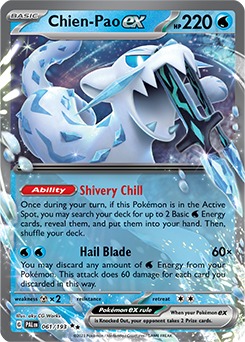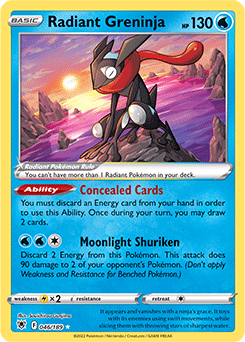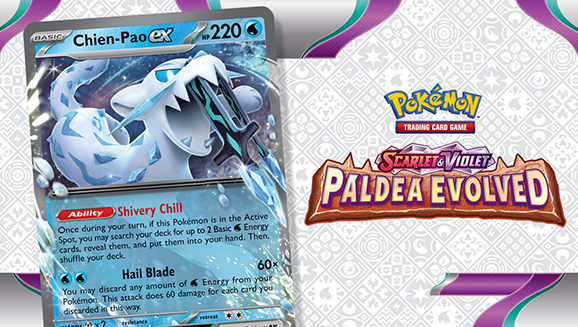By Christopher Schemanske, Contributing Writer

Since the early days of the Pokémon Trading Card Game, most decks have taken a straightforward approach: put as much Energy into play as possible, and then attack with a Pokémon that does a lot of damage using that Energy. Rain Dance was the Ability that best powered this approach in the past; today, it’s found a new champion in Baxcalibur’s Super Cold Ability. This Ability forms the basis of Baxcalibur’s synergy with Chien-Pao ex, uniting them into a torrential twosome that has been making waves since the release of Scarlet & Violet—Paldea Evolved. The duo even had a successful debut at the North America International Championships. Now, let’s take a look at exactly how Chien-Pao ex and Baxcalibur come together in this competitive deck.
Energetic Entrance: The Core Strategy
One of my core beliefs as a Pokémon TCG player is the importance of Energy acceleration—attaching extra Energy cards beyond the one-per-turn allotted by the rules. Without Energy, Pokémon can’t attack, and the most powerful attacks often require multiple Energy cards. Without the capability to attach more Energy, a game can simply end before these cards even get off the ground!

Such would be true of Chien-Pao ex if it didn’t have Baxcalibur by its side. Looking at Chien-Pao ex, we find a relatively straightforward, powerful attack in Hail Blade, which does 60 damage for each Water Energy discarded from our team. Chien-Pao is going to need four, five, or even six Energy cards before it can deliver the one-hit Knock Outs needed to keep up with the Standard format’s other stalwarts, and we certainly don’t have six turns to wait. This is what makes Baxcalibur a necessity. With such a voracious appetite for Energy, the Chien-Pao ex / Baxcalibur combo would normally need to have a whole buffet of Trainer cards that help it access Energy. However, Chien-Pao ex helps its own case with its powerful Shivery Chill Ability, which allows us to find 2 Water Energy from the deck every turn while it’s in the Active Spot.
And thus we are at that classic, relatively straightforward strategy: set up Baxcalibur, attach lots of Energy, do as much damage as necessary, and repeat until no Prize cards remain. Easy, right? Not quite. The fact that Chien-Pao ex didn’t run away with NAIC is sufficient proof that things aren’t as simple as they seem, but we’ll circle back on that later. In the meantime, let’s get into the details of building out our deck. Here’s a deck list I’ve been working with:
Pokémon Primer: The Stars of the Show
Let’s talk through what we’re working with. For starters, we have three of all the core Pokémon: Chien-Pao ex, Frigibax, and Baxcalibur. While four would be lovely, we don’t want to fill up our hand all game with things we don’t need, so that extra space goes to Trainer cards to help us get the right Pokémon at the right time. In Frigibax, there’s a classic dilemma—a 60-HP, one-Retreat Cost option versus a 70-HP, two-Retreat Cost candidate. In this case, because we want to get Chien-Pao ex Active ASAP to begin searching for Energy, I believe the 60 HP/one Retreat Cost is the better choice.
The rest of the Pokémon are dedicated to a specific use or strategy. For starters, the thin Arceus VSTAR line has a dual purpose. Most importantly, it provides a very powerful VSTAR Power that can help get Baxcalibur rolling or provide an extra late-game push to achieve a key Knock Out. In addition, it provides an attacker that’s not weak to Metal types. While they aren’t numerous in today’s Standard format, diversifying Weaknesses is always a good strategy to avoid nasty surprises.

Radiant Greninja and Lumineon V are both dedicated to setting up our strategy, with both helping to find the cards necessary to get Baxcalibur in place ASAP. Manaphy helps prevent opposing Radiant Greninja or other Bench-focused attackers from picking off our poor Frigibax before they have the chance to evolve. Spiritomb is a targeted addition. Without it, Mew VMAX has free rein to be faster, and therefore more successful, than our Water-type friends; Fettered in Misfortune provides a way to level the playing field.
Talking Trainers: The Core Engine
Every Stage 2 deck has a key problem: setting up a Stage 2 Pokémon consistently and quickly requires a lot of dedicated Trainer cards! Deck space quickly gets very tight, so deciding which corners to cut is the most important element of selecting the Trainer lineup. This deck has a special version of this problem—the required recycling of Energy cards also requires its own suite of Trainer cards to be effective.
Every deck begins with its Supporter lineup, and there are two clear directions in this case. Iono, introduced in Scarlet & Violet—Paldea Evolved, is the most popular option to center a Supporter suite these days. However, while I appreciate that it’s able to provide a clean hand of six cards early in the game, this deck isn’t one that plays “off the board” very well. Every turn, you need to attach more Energy to keep things moving at peak capacity. A late-game Iono that draws two or three cards isn’t very exciting even when it’s the result of your opponent’s Supporter—when it’s your own Supporter, it’s downright dreadful.

As a result, I’ve chosen to focus on a more search-heavy route. Thus, Irida takes center stage due to its ability to search out specific cards that help in a given situation. One of the most important card combinations in the deck is Rare Candy plus Baxcalibur, and incidentally, Irida can grab both at once! That alone makes it a powerful option in my mind, but it gets bonus points for added utility both before and after that Turn 2 Baxcalibur. Going first? Irida for Battle VIP Pass and a Chien-Pao ex means everything is set up for next turn. Need to get that last Knock Out? Superior Energy Retrieval and a sacrificial Frigibax to discard coming right up. While Irida doesn’t offer the clean hand refresh that Iono does, it offers a steady way to get exactly what we need. In my mind, that’s a worthwhile tradeoff.
Iono is still exceptionally versatile and therefore quite valuable, so we’re keeping a copy. There’s no comparison for the amount of chaos it can cause an opponent in the late game, and being able to keep an opponent on their toes is always good. If you’re having trouble with pesky Comfey-based decks, it’d be worthwhile to add more Iono—they are not fans of having their hands taken away! The copy of Professor’s Research allows for similar niche situations, where perhaps you’re throwing away cards that aren’t necessary anymore, or simply looking to dig hard for a pile of Energy. Lumineon V is especially helpful in a pinch for accessing either of these singletons.
I’ve seen a range of Boss’s Orders counts in this strategy, but I think three is a solid number. Being able to choose what you’re attacking is supremely valuable, especially in games in which you set up quickly. If you take the first two-Prize Knock Out of a game (courtesy of an opponent’s Pokémon V or Pokémon ex), it doesn’t really matter what your opponent does for the rest of the game as long as you take two Prize cards every turn. As a result, there are some matchups where it makes more sense to use Boss’s Orders to retrieve a sitting Squawkabilly ex, Lumineon V, or other frail foe than it does to attack head-on into something hefty like Duraludon VMAX. They can sometimes clog your hand when you don’t need them, though, and I could see an argument for including a second copy of Iono or Professor’s Research over the third Boss’s Orders.

The theme of our Item suite is very simple—consistently finding what we need when we need it. Hefty counts of Battle VIP Pass hope to get the party started quickly, finding our Basic Pokémon ASAP, while Nest Ball and Ultra Ball circle in to help fill the gaps. I feel good about including 10 search cards simply because of how important it is to get the right Pokémon quickly. Although Battle VIP Pass is not useful after Turn 1, it is useful fodder to discard with Ultra Ball and Superior Energy Retrieval, which makes the downside far easier to bear.
Speaking of Superior Energy Retrieval, it’s really the enabler in all this Energy consumption. Without its efficient ability to get Energy back from the discard pile, we’d have trouble hitting the appropriate damage numbers needed to take six Prize cards in Standard. Luckily, those search cards are easy to discard once things are set up, which makes the discard cost not too painful to pay. Just avoid playing Iono when you can only draw one card off it, which does not easily lend itself to playing a Superior Energy Retrieval.
Most decks in Standard today need to play a Stadium card of some sort, even if only to disrupt your opponent’s Stadium strategy. I’ve emphasized consistency here with my choice of Artazon, looking to find Frigibax as soon as possible. Other choices include Skaters’ Park and PokéStop. Skaters’ Park is cool, but not consistently useful enough to be worthwhile, and in my mind, and PokéStop is just a bit too brave for a Stage 2 deck. Both are worth playing around with, though. You may find success!
Pointers for Play: Basic Strategy

Before we wrap up, let’s talk through the basic strategy. All in all, the essential ingredient for success is Baxcalibur. Accordingly, on Turn 1, the goal is to find one (or, if playing against a deck that could pick one off quickly, two) Frigibax. If Chien-Pao ex can find its way to the Active Spot and start amassing Energy, that would be an excellent bonus. While Energy is important, discarding a few early isn’t the end of the world, as Superior Energy Retrieval can swoop in to recover any early casualties. Otherwise, ensuring that you play your Turn 1 hand as well as possible to facilitate the Turn 2 Baxcalibur is the way to go. If things look dire, fishing out Arceus V and using Starbirth quickly is a great option.
In the later game, it’s important to be careful about the Energy resources remaining. This includes keeping track of Superior Energy Retrievals, but also things like Boss’s Orders and how much Energy will be needed to take the Prize cards needed to win. Against other Evolution decks or Comfey-focused variants, one quick route to two Prize cards could be Radiant Greninja—Moonlight Shuriken can be a nasty surprise for an unprepared opponent.
With unlimited damage potential and a relatively straightforward setup, the Chien-Pao ex / Baxcalibur duo has the potential to be a tournament-winning combination. Though their foes are many, the combination of an uncommon Weakness and straightforward synergy make the deck a solid option. May you ride the waves of success, everyone!

Christopher Schemanske is a contributing writer for Pokemon.com. He's been playing the Pokémon TCG since 2010, with a streak of Worlds invitations between 2012–2018. Nowadays, he enjoys splitting his Pokémon time between playing and being part of the awesome Professor staff teams at major events.


